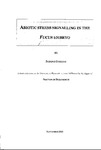ABIOTIC STRESS SIGNALLING IN THE FUCUS EMBRYO
| dc.contributor.author | COELHO, SUSANA | |
| dc.contributor.other | Faculty of Science and Engineering | en_US |
| dc.date.accessioned | 2013-11-19T11:51:28Z | |
| dc.date.available | 2013-11-19T11:51:28Z | |
| dc.date.issued | 2002 | |
| dc.identifier | NOT AVAILABLE | en_US |
| dc.identifier.uri | http://hdl.handle.net/10026.1/2762 | |
| dc.description.abstract |
Fucoid algae live in the intertidal region where they experience daily fluctuations in light and external osmotic environment. High light, especially in combination with ultraviolet (UV) radiation and hyper-osmotic stress affected the cellular physiology of Fucus embryos. Two photoinhibition responses were recognised. Firstly, a rapid decline of the photosystem II (PSII) efficiency, linked with the operation of the xanthophyl cycle, followed by a slower decline correlated with reactive oxygen species (ROS) production. As a result of enhanced ROS production, a slower repair of the PSII efficiency was observed, particularly with increased UV-B doses. Development of the embryos was transiently affected by UV-B. The cellular signal transduction pathway during hyper-osmotic stress was investigated. ROS production in response to hyperosmotic stress comprised two distinct components. The first ROS component coincided closely with the origin of a Ca2+ wave in the peripheral cytosol at the growing cell apex, had an extracellular origin, and was necessary for the Ca2+ wave. Patch clamp experiments showed that a non-selective cation channel was stimulated by H2O2, and may underlie the initial cytosolic Ca2+ elevation. The spatio-temporal pattern of the Ca2+ wave was thus determined by peripheral ROS production. The second, later ROS component localised to the mitochondria and was a direct consequence of the Ca2+ wave. The first, but not the second component was required for short-term adaptation to osmotic stress, probably through the activity of cell wall bromoperoxidases. Mitogen-activated protein kinases may be involved in the hyper-osmotic stress response downstream or independently of the mitochondrial ROS production. | en_US |
| dc.description.sponsorship | Marine Biological Association of the UK | en_US |
| dc.language.iso | en | en_US |
| dc.publisher | University of Plymouth | en_US |
| dc.title | ABIOTIC STRESS SIGNALLING IN THE FUCUS EMBRYO | en_US |
| dc.type | Thesis | |
| plymouth.version | Full version | en_US |
| dc.identifier.doi | http://dx.doi.org/10.24382/3576 |
Files in this item
This item appears in the following Collection(s)
-
01 Research Theses Main Collection
Research Theses Main


